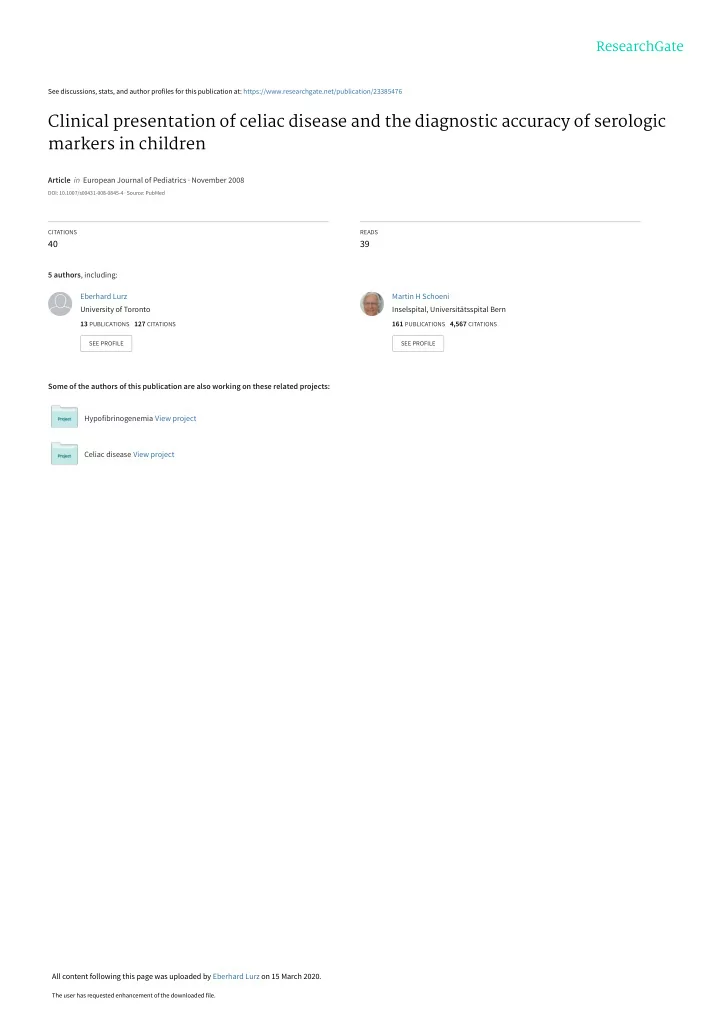

See discussions, stats, and author profiles for this publication at: https://www.researchgate.net/publication/23385476 Clinical presentation of celiac disease and the diagnostic accuracy of serologic markers in children Article in European Journal of Pediatrics · November 2008 DOI: 10.1007/s00431-008-0845-4 · Source: PubMed CITATIONS READS 40 39 5 authors , including: Eberhard Lurz Martin H Schoeni University of Toronto Inselspital, Universitätsspital Bern 13 PUBLICATIONS 127 CITATIONS 161 PUBLICATIONS 4,567 CITATIONS SEE PROFILE SEE PROFILE Some of the authors of this publication are also working on these related projects: Hypofibrinogenemia View project Celiac disease View project All content following this page was uploaded by Eberhard Lurz on 15 March 2020. The user has requested enhancement of the downloaded file.
Eur J Pediatr (2009) 168:839 – 845 DOI 10.1007/s00431-008-0845-4 ORIGINAL PAPER Clinical presentation of celiac disease and the diagnostic accuracy of serologic markers in children Eberhard Lurz & Ursina Scheidegger & Johannes Spalinger & Martin Schöni & Susanne Schibli Received: 5 April 2008 /Accepted: 22 September 2008 / Published online: 16 October 2008 # Springer-Verlag 2008 Abstract There has been growing recognition of a changing children with CD and relative IgA deficiency (IgA levels clinical presentation of celiac disease (CD), with the that are measurable but below the age reference [ n =8]) had manifestation of milder symptoms. Serologic testing is elevated IgA-tTG. In conclusion, CD is frequently diagnosed widely used to screen patients with suspected CD and in school-age children with relatively mild symptoms. The populations at risk. The aim of this retrospective analysis absence of intestinal symptoms does not preclude the was to evaluate the clinical presentation of CD in childhood, diagnosis of CD; many children with CD do not report assess the diagnostic value of serologic tests, and investigate intestinal symptoms. While the sensitivity of IgA-tTG is the impact of IgA deficiency on diagnostic accuracy. We excellent, its specificity is insufficient for the diagnostic evaluated 206 consecutive children with suspected CD on confirmation of a disease requiring life-long dietary restric- the basis of clinical symptoms and positive serology results. tions. Children with negative IgA-tTG and decreased but Ninety-four (46%) had biopsy-proven CD. The median age measurable IgA values are unlikely to have CD. at diagnosis of CD was 6.8 years; 15% of the children were Keywords Celiac disease . Clinical presentation . <2 years of age. There was a higher incidence of CD in girls Screening . IgA deficiency. Tissue transglutaminase (tTG) ( p =0.003). Iron deficiency and intestinal complaints were more frequent in children with CD than those without CD (61% vs. 33%, p =0.0001 and 71% vs. 55%, p =0.02, Abbreviations respectively), while failure to thrive was less common tTG Tissue transglutaminase (35% vs. 53%, p =0.02). The sensitivity of IgA tissue AGA Antigliadin antibodies transglutaminase (IgA-tTG) was 0.98 when including all EMA Endomysium antibodies children and 1.00 after excluding children with selective IgA CD Celiac disease deficiency. The specificity of IgA-tTG was 0.73 using the T1DM Type 1 diabetes mellitus recommended cut-off value of 20 IU, and this improved to FTT Failure to thrive 0.94 when using a higher cut-off value of 100 IU. All E. Lurz : U. Scheidegger : J. Spalinger : M. Schöni : S. Schibli Introduction University Children ’ s Hospital Berne, Bern, Switzerland Celiac disease (CD) is an immune-mediated enteropathy J. Spalinger triggered by the ingestion of gluten, which affects geneti- Children ’ s Hospital Lucerne, cally predisposed individuals [6, 14]. It is one of the most Lucerne, Switzerland common life-long disorders, with an estimated prevalence S. Schibli ( * ) ranging from 3 to 13 per 1,000 children in the general Paediatric Gastroenterology and Hepatology, population in Europe and North America [14, 15, 19, 28]. A University Children ’ s Hospital Berne, recent study in asymptomatic adolescents in eastern Switzer- 3010 Bern, Switzerland land revealed a prevalence rate of 1 in 230 adolescents [25]. e-mail: susanne.schibli@insel.ch
Recommend
More recommend